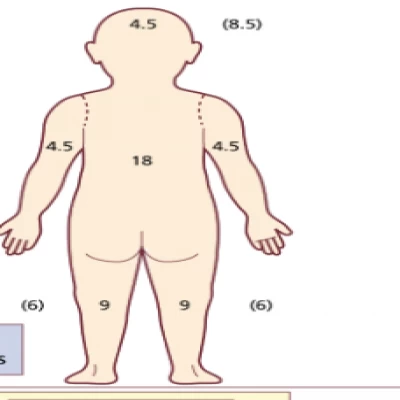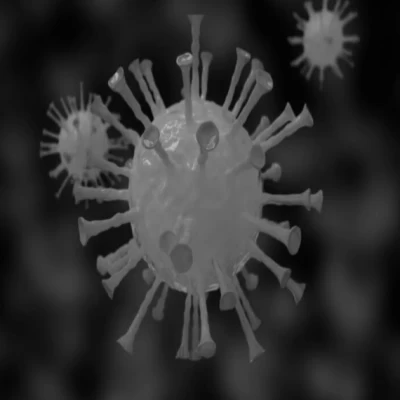مجلات علمية

Influenza viruses are common respiratory tract infections. Seasonal Influenza 2020 was worrying as it conflicted with COVID-19. The similarity in common symptoms is the cause of the conflict.
Influenza viruses are members of the Orthomyxovirus genus which are enveloped ssRNA viruses with segmented genomes.
Structure of Influenza virus:
It's composed of two glycoproteins:
The hemagglutinin(HA) and neuraminidase enzyme, both are inserted into the envelope as projection spikes, 80% of spikes are HA antigen, and 20% are neuraminidase enzymes which are important for virus adsorption and entry into the host cells.
Importance of the spikes:
1- Attachment and penetration of the host cells.
2- Determine the virulence of the virus.
3- The corresponding antibodies to these spikes are necessary for preventing the infection. Anti HA is the most important antibody.
4- The HA antigen helps the virus to agglutinate the red blood cells of the host.
5- NA enzyme helps in the release of the virus from host cells to spread the infection.
Anti-NA prevents the release of newly formed viruses.
Route of transmission and clinical features:
Influenza viruses are classified into three major serotypes: A, B, and C.
Influenza-A serotype has the greatest virulence and epidemic spread.
Infection is transmitted by: 1-Respiratory route by inhalation of aerosol droplets created particularly while talking, sneezing, or coughing.
2-By contact with contaminated hands or surfaces.
Symptoms:
Influenza isn't characterized by a runny nose or sore throat at the start of the infection.
The infected person is manifested by:
Sudden rise in body temperature(fever), headache, limb ache, shivering, malaise, tiredness, general faintness, and dry cough.
Factors affecting the severity of influenza infection:
1- Age of the infected person:
Complications and long duration of infection are more common in old age patients
2- Immune system condition:
Secondary bacterial infections may develop in immunocompromised patients and people with chronic obstructive pulmonary disease(COPD).
3- Smoking or not.
Reye's syndrome:
A rare complication which is associated with Influenza virus serotype-B infection in children and taking of aspirin.
The syndrome is manifested by:
*Encephalopathy.
*And fatty degeneration of the liver.
Genetic variations in influenza viruses:
1- Antigenic shifts:
It's a major Antigenic change that forms a new influenza virus subtypes due to the reassortment of genes.
Ex. Infection of a single cell by two different influenza-A viruses can lead to the exchange of any of the 8 genes of each parent to create a new virus with genes from both parents.
The new influenza virus subtype has new antigenic properties in one or both viral glycoproteins(HA, NA)
Ex. H1N1, H2N2, H3N1.
2- Antigenic drifts:
It's a minor antigenic change due to mutations in amino acids sequences of HA antigen.
It can affect both Influenza virus serotype-A and B.
Prophylaxis:
1-Chemoprophylaxis:
★ Influenza-A viruses (not B & C) are treated by amantadine and rimantadine, antiviral drugs that inhibit viral uncoating.
★ Two neuraminidase enzyme inhibitors are currently available for the treatment of both Influenza-A and Influenza-B
*Oseltamivir(Tamiflu) and *Zanamivir(Relenza).
These drugs can decrease symptoms of Influenza if taken within two days of the onset of illness and reduce the duration of uncomplicated infection.
2-Influenza virus vaccines:
It's highly recommended for high-risk individuals ( Elderly and patients with lung or heart diseases).
A- Inactivated vaccine:
Prepared from the strains that are most closely related to the antigenic subtypes currently causing infections (usually in the autumn season every year).
The virus is grown in the chick embryo and then inactivated with formalin or B-propiolactone.
Most of the inactivated vaccines are either subunit purified HA and NA or split vaccines that are extracted in ether and detergent to reduce the side effects of the whole viral vaccines.
B- Subunit vaccine:
This vaccine contains HA or NA to reduce the side effects of the whole viral vaccine.
1- Virus is grown in eggs, purified and concentrated.
2- Viral lipids are dissolved by detergent to release viral proteins and nucleic acids which are then removed.
3- HA and NA subunits are purified by ultracentrifugation.
4- Standardized quantities of either HA or NA are incorporated into the final product.
C- Live attenuated vaccines:
Prepared from selected mutants that have diminished virulence for humans and can grow only at low temperatures.
It's used intranasally.
Influenza 2020:
The source of the following data is FluNet and EMFLU and the World Health Organization(WHO) regional office for the Eastern Mediterranean.
Influenza 2020 monthly updates:
Statistics of seasonal Influenza 2020(January 2020):
In January 2020, FluNet and EMFLU have been reported by many countries that they have an epidemic spread of the Influenza virus.
Some of these countries are:
Afghanistan, Egypt, Bahrain, Iraq, Iran, Jordan, Kuwait, Lebanon, Morocco, Oman, Qatar, Saudi Arabia, Syria, U.A.E, and Tunisia.
Influenza activity by subtypes in January 2020:
A- In Northern Africa:
Influenza activity with Influenza-A (H1N1) pdm09 continued to reduce in Egypt, Tunisia, and Morocco, and Influenza-B was most detected.
B- In Western Asia:
In Iraq and Qatar: Influenza activity with Influenza-A(H1N1) pdm09 and Influenza-B virus co-circulating remained elevated.
In Kuwait, Oman, and Saudi Arabia:
Influenza activity with Influenza-A and Influenza-B viruses was detected but continued to reduce.
In Lebanon:
Influenza-B and Influenza-A were predominating but they appeared to decrease at the end of the month.
C- In Southern Asia:
In Iran:
Influenza activity remained elevated with Influenza-B most frequently detected.
In Afghanistan and Pakistan:
Influenza-A and Influenza-B were co-circulating, but their activity continued to decrease.
Statistics of seasonal Influenza 2020(February 2020):
In February 2020, FluNet and EMFLU have been reported by many countries that they have an epidemic spread of the Influenza virus.
Some of these countries are:
Afghanistan, Egypt, Bahrain, Iraq, Iran, Jordan, Kuwait, Lebanon, Morocco, Oman, Qatar, Saudi Arabia, Syria, Sudan, Yemen, U.A.E, and Tunisia.
Influenza activity by subtypes in February 2020:
A- In Northern Africa:
In Egypt and Morocco:
Influenza activity with Influenza-A and Influenza-B remained low.
In Tunisia:
The activity remained high and Influenza-A (H1N1) pdm09 was most frequently detected.
B- In Western Asia:
Influenza-A and Influenza-B were co-circulating.
Influenza activity remained elevated in:
Lebanon, Qatar, and Saudi-Arabia.
Influenza activity continued to reduce in:
Bahrain, Iraq, Jordan, Kuwait, Yemen, and Oman.
C- In Southern Asia:
In Iran:
Influenza activity remained elevated with Influenza-B most frequently detected.
In Afghanistan :
Influenza-A and Influenza-B were co-circulating, but their activity continued to decrease.
Statistics of seasonal Influenza 2020(March 2020):
In March 2020, FluNet and EMFLU have been reported by many countries that they have an epidemic spread of the Influenza virus.
Some of these countries are:
Afghanistan, Egypt, Bahrain, Iraq, Iran, Jordan, Kuwait, Lebanon, Morocco, Oman, Pakistan, Qatar, Saudi Arabia, Syria, Sudan, Yemen, U.A.E, and Tunisia.
Influenza activity by subtypes in March 2020:
A- In Northern Africa:
In Tunisia:
Influenza activity reduced, with Influenza-A (H1N1) pdm09 most frequently detected, followed by Influenza-B viruses.
In Morocco:
Sporadic cases of Influenza-A and Influenza-B were reported.
B- In Western Asia:
In Qatar:
Influenza activity continued to decrease with Influenza-A (H1N1) pdm09 most frequently detected.
In Saudi Arabia:
Influenza-B was the most frequently detected.
In Lebanon and Yemen:
Sporadic cases of Influenza-A and Influenza-B were reported.
C- In Southern Asia:
In Iran:
Reduced Influenza activity with Influenza-B is most frequently detected.
Statistics of seasonal Influenza 2020 (from April to June 2020):
In March:
Influenza-A (H1N1) pdm09 was most frequently detected and attributed to 35% of the positive cases, while Influenza-A (H3) was the least reported subtype (6%).
In April:
In contrast to March, influenza-A H3 was the most predominantly reported subtype and attributed to 55% of cases, while influenza-A H1N1 pdm09 was attributed to 18% of the positive cases.
In May:
influenza-A (H1N1) pdm09 was the most frequently detected (54%).
In June:
influenza-A (H3) was the most frequently detected subtype and attributed to 50% of cases.
Spread of Seasonal Influenza 2020 from April to June 2020:
Between April and June 2020, 15 countries in the Eastern Mediterranean Region have reported to FluNet and EMFLU to have an epidemic spread of seasonal influenza virus.
Egypt, Iran, Jordan, Kuwait Lebanon, Iraq, Bahrain, Lebanon, Morocco, Oman, Palestinian, Syria, United Arab Emirates, and Qatar.
Statistics of seasonal Influenza 2020 (from July to September 2020):
In June:
influenza-A (H3) was the most frequently detected subtype and attributed to 50% of the positive cases, while Influenza-A (unsubtyped) was the least reported subtype (12%).
In July:
In contrast to June, influenza-A (H1N1) pdm09 was the most predominantly reported subtype and attributed to 55% of cases, while influenza-A (H3) was attributed to 18% of the positive cases.
In August:
influenza-A (H1N1) pdm09 was the most frequently detected (64%).
In September:
influenza-A (H1N1) pdm09 was the most frequently detected subtype and attributed to 62% of the positive cases.
Spread of Seasonal Influenza 2020 from July to September 2020:
Between July and September, 13 countries in the Eastern Mediterranean Region have reported data to FluNet and EMFLU.
Statistics of seasonal Influenza 2020 (from October to December 2020):
In September:
influenza-A (H1N1) pdm09 was the most frequently detected subtype and attributed to 62% of the positive cases, while influenza-A H3 was the least reported subtype and attributed to 15% of the positive cases.
In October:
Influenza virus subtype-B (lineage not determined) was the most predominantly reported subtype and attributed to 45% of the positive cases, while influenza-A (H1N1) pdm09 was the least reported subtype and attributed to 11% of the positive cases.
In November:
Influenza-B (lineage not determined) was the most frequently detected subtype and attributed to 53% of the positive cases.
In December:
Influenza-B (lineage not determined) was the most frequently detected subtype and attributed to 67% of the positive cases.
Spread of Seasonal Influenza 2020 from October to December 2020:
Between October and December 2020, 15 countries in the Eastern Mediterranean Region have reported data to FluNet and EMFLU.
Seasonal Influenza 2020 vaccination:
From what flu vaccines 2020-2021 protect against?
A- 2020-2021 Trivalent vaccine (three components):
It's an egg-based vaccine contained:
1- A/Guangdong-Maonan/SWL 1536/2019 (H1N1) pdm09 -like a virus.
2- A/Hong Kong/2671/2019/H3N2
-like a virus.
3- B/Washington/02/2019(B/ Victoria lineage)-like virus.
B- 2020-2021 Quadrivalent vaccine (Four components):
It's an egg-based vaccine which protects against Influenza-B second lineage viruses, it's composed of:
The same three viruses in the trivalent vaccine plus Influenza-B/Phuket/3073/2013-like (Yamagata lineage) virus.
C- 2020-2021, cell or recombinant based vaccines:
contained:
1- A/Hawaii/70/2019/(H1N1) pdm09 like virus.
2- A/Hong Kong/45/2019/(H3N2)-like virus.
3- B/Washington/02/2019/(B/
Victoria lineage)-like virus
4- B/Phuket/3073/2013-like (Yamagata lineage) virus.
D- 2020-2021 Northern Hemisphere vaccines:
They were updated and changed from those in the 2019-2020 season, to better match the flu viruses that were expected to circulate this year.
1- The egg-based H1N1 vaccine was updated to an A/Guangdong-Maonan/SWL 1536/2019(H1N1) pdm09 like virus, instead of an A/Brisbane/02/2018(H1N1) pdm09 like virus.
2- The cell or recombinant-based H1N1 vaccine was updated to an A/Hawaii/70/2019/(H1N1) pdm09 like virus, instead of A/Brisbane/02/2018/(H1N1) pdm09 like virus.
3- The egg-based H3N2 vaccine component was updated to an A/Hong Kong/2671/2019/H3N2-like virus, instead of an A/Kansas/14/2017/(H3N2) like virus.
4- The cell or recombinant-based H3N2 vaccine component was updated to an A/Hong Kong/45/2019/(H3N2) like virus, instead of an A/Kansas/14/2017/(H3N2) like virus.
5- The B/Victoria lineage vaccine component was updated to a B/Washington/ 02/2019(B/Victoria lineage)-like virus, instead of a B/Colorado/06/2017/
(B/Victoria lineage)-like virus.
6- The B/Yamagata lineage vaccine component wasn't updated.
Seasonal Influenza 2020 vaccines recommendations during the flu season 2020-2021:
Vaccination options are:
1- Standard dose Influenza shot.
2-People who are 65 years or older are recommended for high-dose shots and shots made with adjuvant.
3- Vaccines made with viruses grown in cell culture, ensure that no eggs are involved in the production process of those vaccines.
4- Recombinant-based vaccines shouldn't require having a CCV (candidate vaccine virus).
5- Live attenuated vaccines are given intranasally as nasal sprays.
Summary:
Influenza viruses are members of the family Orthomyxoviridae, there are four genera of this family: types A, B, C, and Thogotovirus,
however only genera A and B are clinically found in humans.
Prevention and early control of flu cases are necessary to decrease the risk of complicated respiratory infections.






